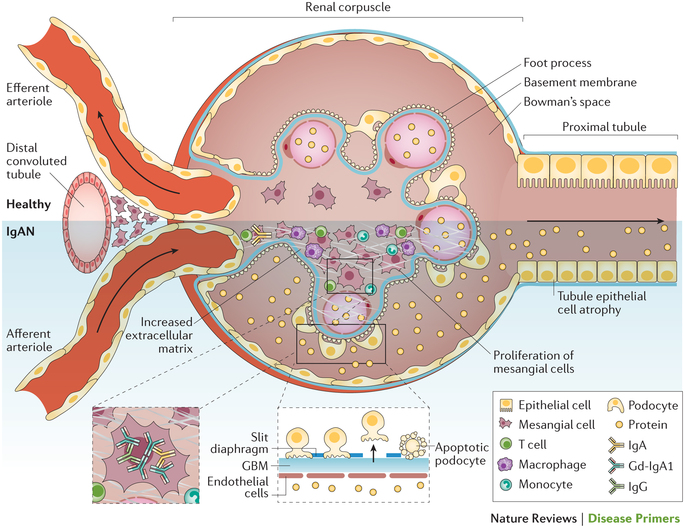IgA腎症
IgA nephropathy
2016年2月11日 Nature Reviews Disease Primers Article number: 16001 (2016) doi: 10.1038/nrdp.2016.1

IgA腎症(IgAN)は世界で最もよく見られる腎不全に進行し得る原発性糸球体腎炎である。IgANの正確な発症機序はよく分かっていないが、最新の生化学的および遺伝学的データから、糖鎖不全IgA1の過剰発現が関係していることが示されている。これらの異常な免疫グロブリンは、ヒンジ部O-結合型糖鎖のガラクトース欠損を特徴としている。しかし、糖鎖不全だけでは腎障害は誘発されない:それにはガラクトシル化が不十分なIgA1分子を認識する糖鎖特異的IgAおよびIgG自己抗体が関与する必要がある。ガラクトシル化が不十分なIgA1を含む免疫複合体が糸球体に沈着するとメサンギウム細胞が活性化し、サイトカイン、ケモカインおよび補体が局所で過剰に発現されるようになる。メサンギウム領域にIgA1が沈着すると、メサンギウム細胞由来メディエーターが放出され、液性クロストークを通して足細胞障害および尿細管間質性損傷が誘発されることが最新のデータで明らかになった。無症候性顕微鏡的血尿から肉眼的血尿まで、患者にはさまざまな兆候や症状が現れる。その臨床的進行は多様であり、最初の臨床像から20~30年後には患者の30~40%が末期腎不全に至る。現在、IgANに特異的な治療法はなく、患者の血圧管理と腎機能維持を目的とした治療が行われている。しかし現在、疾患の病因に関するこれまでに深化したわれわれの理解を基礎として、新しい治療アプローチが開発されている。
PrimeView
IgA腎症はよく見られる糸球体腎炎であり、自己抗原として認識される糖鎖異常IgA1によって惹起されると考えられている。このPrimeViewでは、この疾患に関する妥当と考えられる機序とともに患者の管理方法について取りまとめる。
本Primerの図解サマリー

